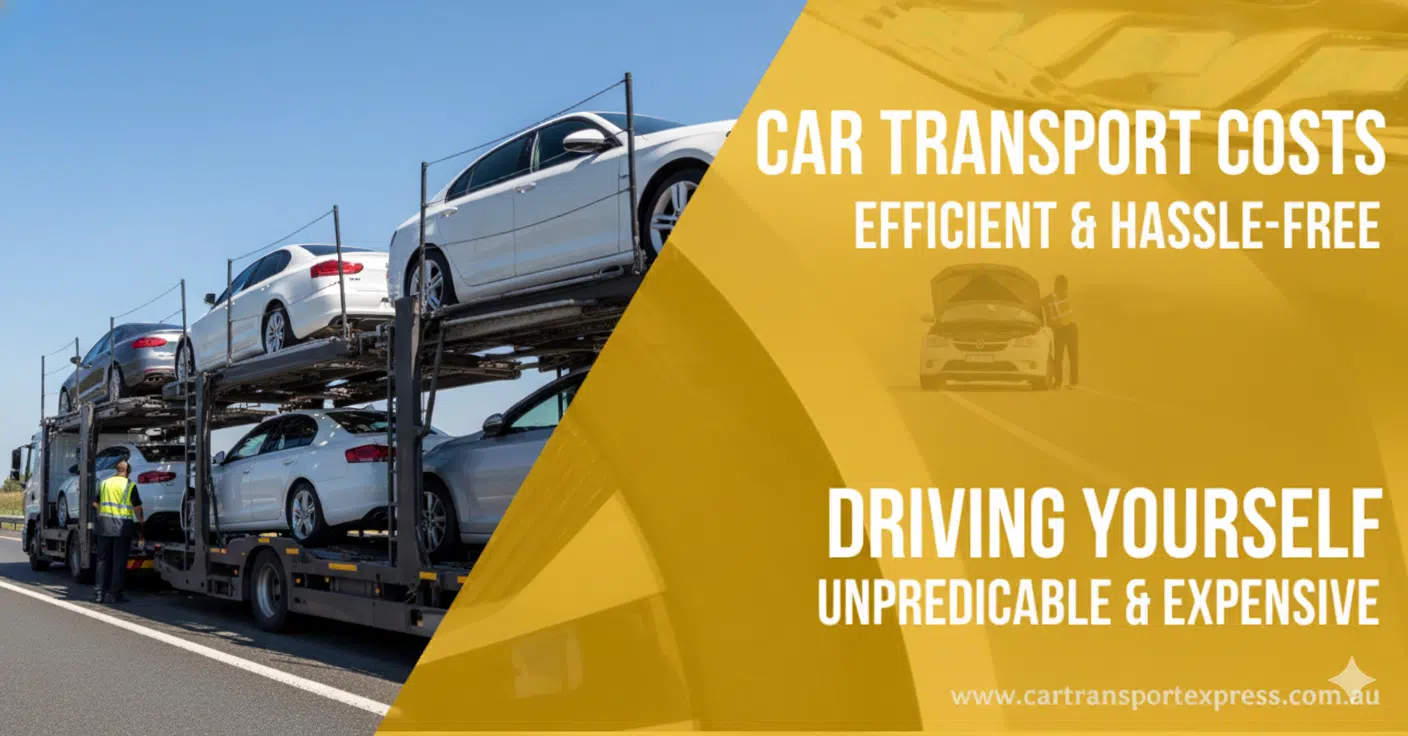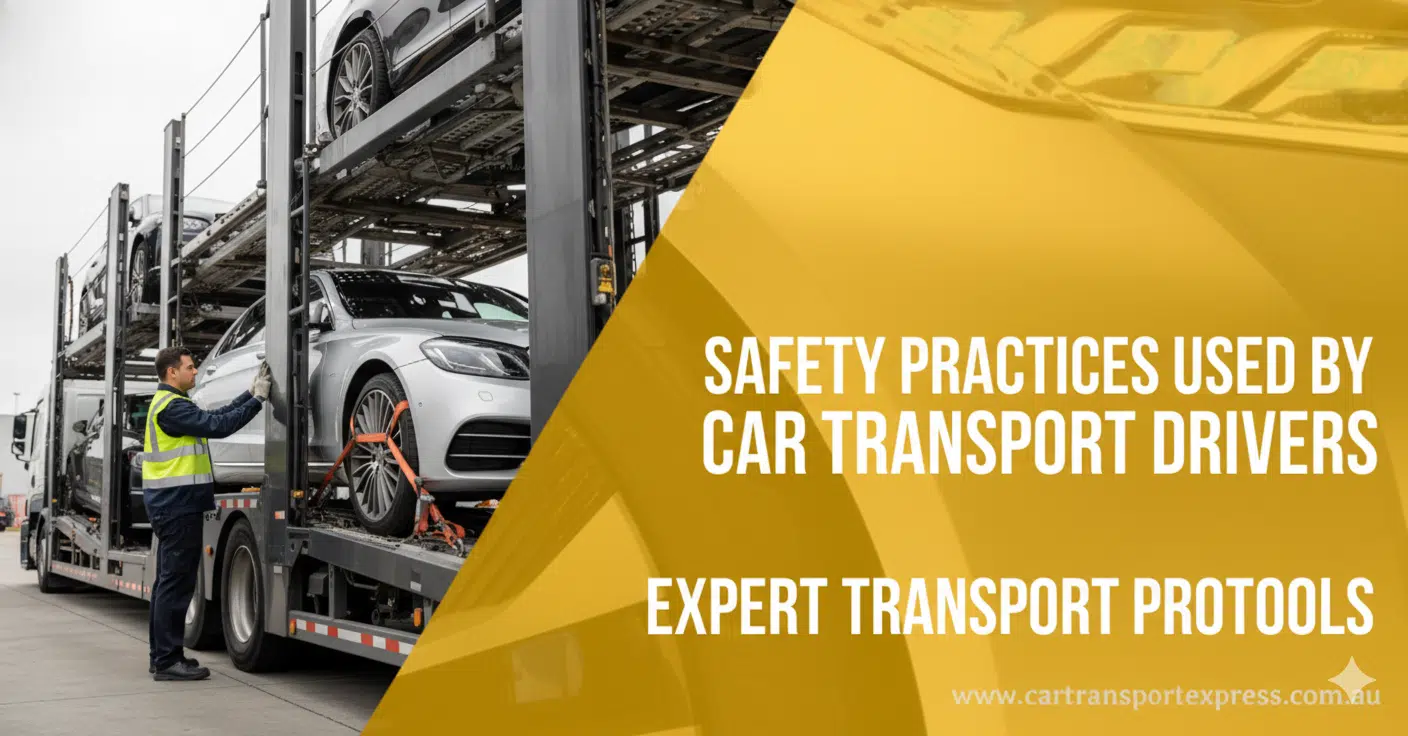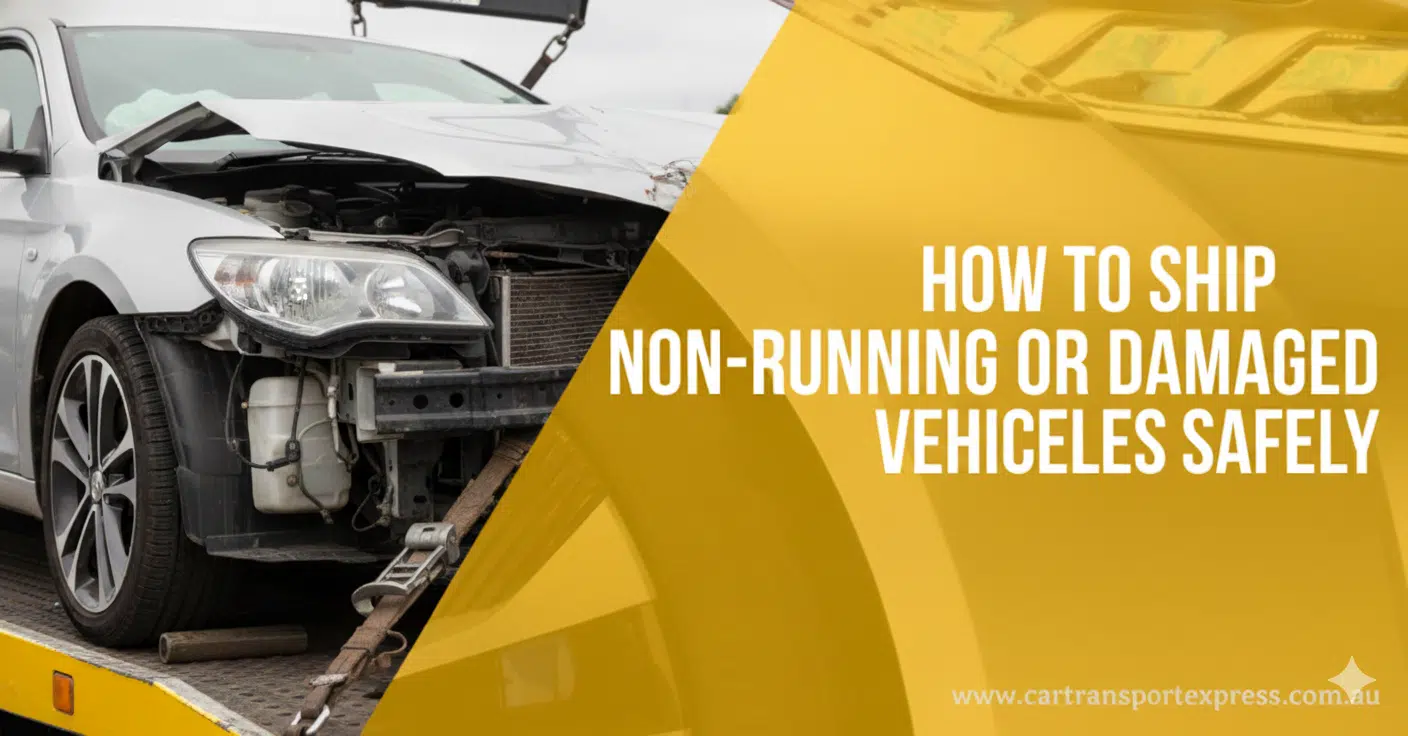Car Transport Costs vs Driving Yourself: The Real Breakdown
4 min read
Key Takeaways
- Driving long distances yourself often costs more when factoring in fuel, wear, time, and accommodation.
- Professional car transport offers convenience, safety, and insurance coverage at a competitive price.
- Using transport services prevents fatigue, breakdown risks, and vehicle depreciation.
- Driving yourself may only make sense for short trips or leisure journeys.
- Overall, car transport is the smarter and often cheaper option for long-distance relocations.
When it comes to relocating your vehicle across cities or states in Australia, one question inevitably arises: Should you drive it yourself or hire a professional car transport service? At first glance, driving seems like the budget-friendly option, after all, it’s “just fuel,” right? But once you dig deeper into the hidden costs, time, accommodation, wear and tear, and safety, the numbers tell a very different story.
1. The True Cost of Driving Yourself
Many travellers underestimate how quickly expenses snowball when embarking on a long-distance drive. Let’s take a common route: Brisbane to Melbourne, which spans roughly 1,700 km one way.
Here’s a realistic breakdown of what you might spend:
| Expense Category | Estimated Cost |
| Fuel (based on $2.00/L & 10L/100km) | $340 |
| Food & Drinks | $80–$150 |
| Overnight Accommodation | $150–$300 |
| Vehicle Wear & Tear (tyres, oil, depreciation) | $250–$400 |
| Lost Time (2 days @ $300/day personal or business value) | $600 |
| Total Estimated Cost | $1,420 – $1,790 |
And that’s assuming:
- No unexpected detours or breakdowns
- No traffic delays or tolls
- No missed workdays or business opportunities
Driving might feel like an adventure, but financially, it’s far from “free.” Once you factor in the real costs, it often exceeds the price of professional transport, and that’s before considering the stress and fatigue.
2. Car Transport Costs: What You Actually Pay For
Professional car transport services are often more affordable than people expect, especially when you consider what’s included. For the same Brisbane to Melbourne route, prices typically range between $800 and $1,400, depending on:
- Vehicle type
- Service level (open carrier vs enclosed transport)
- Pickup/delivery preferences (door-to-door vs depot-to-depot)
Here’s what that fee covers:
- Professional handling: Your car is loaded, secured, and transported by licensed experts.
- Insurance coverage: Your vehicle is protected throughout the journey.
- Zero wear and tear: No extra kilometres, no tyre damage, no oil changes.
- Flexible logistics: Choose between door-to-door or depot options to suit your schedule.
- Time savings: While your car travels, you can fly ahead, work, or relax.
In short, you’re paying for convenience, safety, and peace of mind, and often saving money in the process.
3. Safety and Stress: The Hidden Factors
Australia’s highways are beautiful, but they’re also long, remote, and occasionally hazardous. Long drives come with risks that are easy to overlook:
- Driver fatigue: A leading cause of road accidents
- Wildlife collisions: Kangaroos and other animals are common hazards
- Breakdowns: Remote areas mean long waits for roadside assistance
By choosing car transport, you eliminate these risks entirely. Your vehicle travels securely, and you avoid the physical and mental toll of multi-day driving.
4. When Driving Might Still Make Sense
Of course, there are situations where driving yourself is the better option:
- Short relocations (under 300 km)
- Road trip plans with sightseeing stops
- Older vehicles with minimal resale value
In these cases, the journey itself may be part of the experience. But for long hauls, newer cars, or time-sensitive moves, transport services are the smarter choice.
The Bottom Line
Driving yourself might seem economical, until you tally up the real costs. Between fuel, food, accommodation, vehicle wear, and lost time, the DIY route can easily cost $1,400 or more.
By contrast, professional car transport offers:
- Lower overall cost
- Greater safety
- No stress
- More time for what matters
So next time you’re planning a move, ask yourself: Is it really worth the drive? Chances are, letting the pros handle it will save you money, and a whole lot of hassle.
Why take on the cost and stress of driving yourself when Car Transport Express can handle it all safely and affordably? Contact us today for a fast quote and discover the easier, smarter way to move your car anywhere in Australia.
Top Safety Practices Used by Car Transport Drivers
5 min read
Key Takeaways:
- Pre-trip inspections and compliance with NHVR standards are essential for safe transport.
- Correct loading and weight distribution ensure stability and prevent accidents.
- Fatigue management, rest breaks, and electronic work diaries support driver safety.
- Defensive and predictive driving techniques reduce risks on long routes.
- Continuous training, GPS tracking, and routine maintenance maintain professional safety standards.
Transporting vehicles across Australia is a specialised task that demands precision, skill, and responsibility. Whether moving a single car or a full load of vehicles, car transport drivers and their transport trucks follow strict safety practices to ensure every journey is completed safely and efficiently. Here’s an inside look at the top safety measures professional drivers use to protect vehicles, themselves, and other road users.
1. Comprehensive Pre-Trip Inspections
Before any transport truck leaves the depot, drivers carry out detailed pre-trip inspections to ensure everything is roadworthy and compliant. This includes checking:
- Tyre condition and pressure on both the prime mover and trailer
- Brakes, air lines, and hydraulic systems
- Trailer couplings, ramps, and securing chains
- Lights, reflectors, and warning beacons
- Load restraints and tie-down points
Identifying potential issues before departure helps prevent mechanical failures and ensures the transport truck meets all National Heavy Vehicle Regulator (NHVR) safety standards.
2. Correct Vehicle Loading and Securing
Loading vehicles onto a transport truck requires precise technique. Drivers position each vehicle based on its weight and dimensions to maintain the truck’s balance and stability.
Each car is then secured using rated straps, chains, or wheel locks in accordance with the National Load Restraint Guide. Proper weight distribution is critical to safe handling and braking performance, particularly when navigating steep or uneven terrain.
3. Fatigue Management and Rest Compliance
Operating a loaded transport truck for long hours demands full concentration. To reduce fatigue-related risks, drivers must comply with NHVR fatigue management rules, which regulate driving and rest hours. Professional operators often use Electronic Work Diaries (EWDs) to log rest periods and ensure they remain within legal limits. Regular breaks, hydration, and proper sleep schedules are key to maintaining alertness on long routes.
4. Defensive and Predictive Driving Techniques
Car transport trucks can stretch 20 metres long or longer and weigh many tonnes when fully loaded. Because of this, defensive driving is essential.
Experienced drivers:
- Maintain longer following distances to account for braking lag
- Use low gears for better control on descents
- Avoid sudden lane changes or harsh braking
- Continuously scan ahead for hazards such as merging traffic or wildlife
Predictive driving keeps the transport truck stable, prevents load shift, and reduces the risk of accidents.
5. Routine Truck and Trailer Maintenance
Regular maintenance is one of the cornerstones of transport safety. Fleet vehicles undergo scheduled mechanical inspections covering the engine, suspension, braking system, and hydraulics. Trailer components, including ramps, winches, and load restraints, are also checked frequently. Preventative maintenance reduces breakdowns on the road and ensures the transport truck performs reliably under all conditions.
6. Communication and Tracking Systems
Modern transport trucks are equipped with GPS tracking systems and telematics that allow operators to monitor routes, driving behaviour, and vehicle performance in real time.
Drivers can instantly report incidents, weather changes, or delays to dispatch teams. This level of communication ensures fast responses and helps maintain consistent delivery schedules without compromising safety.
7. Route and Weather Planning
Professional drivers plan each trip carefully, factoring in weather forecasts, roadworks, bridge clearances, and gradients. High winds, heavy rain, and poor visibility can all impact the handling of a loaded transport truck, so planning ahead is crucial. Route planning also ensures compliance with heavy vehicle route restrictions and bridge weight limits.
8. Ongoing Training and Professional Conduct
Professional car transport drivers undergo continuous training to stay current with industry regulations and safety standards. Training often covers:
- Load restraint and weight distribution
- First aid and emergency procedures
- Vehicle dynamics and braking control
- Customer service and incident reporting
A well-trained driver not only protects the vehicles they carry but also represents the high safety standards of the broader road transport industry.
Conclusion
Safety in car transport is about far more than just driving carefully, it’s a complete system of truck maintenance, driver discipline, and operational planning. From thorough pre-trip inspections to fatigue management and route planning, every safety practice plays a part in ensuring vehicles reach their destination securely and on time. Behind every safe delivery is a driver and transport truck working together with professionalism and precision.
At Car Transport Express, safety isn’t just a policy, it’s our promise. Every driver follows industry-leading safety standards to ensure your vehicle arrives in perfect condition. Request a quote today and move your car with confidence and peace of mind.
How to Ship Non-Running or Damaged Vehicles Safely
4 min read
Key Takeaways
- Non-running or damaged vehicles need specialised equipment and experienced transporters.
- Always disclose the car’s exact condition to avoid safety issues or delays.
- Prepare the vehicle by removing personal items, securing loose parts, and ensuring accessibility.
- Professional carriers use tilt trays, winches, and proper tie-down methods to load safely.
- Accurate communication and planning prevent extra costs and damage during transport.
Moving a car that doesn’t start, has accident damage, or can’t be driven requires a different approach than standard vehicle transport. Non-running or damaged cars need special handling, equipment, and planning to ensure they’re moved safely without causing further harm. Whether you’re relocating, selling a project car, or moving a vehicle after an insurance claim, understanding how to properly ship a non-runner can save time, stress, and unnecessary costs.
1. What Counts as a Non-Running Vehicle?
A non-running vehicle is any car that can’t be driven onto a truck under its own power.
Common reasons include:
- Flat battery or electrical fault
- Engine or transmission failure
- Accident or flood damage
- Missing keys or immobiliser issue
- Severe mechanical problems preventing movement
Transporting such vehicles safely depends on accurately describing their condition when booking, as this determines the equipment and carrier needed.
2. Choose a Transport Company Experienced with Non-Runners
Not every carrier is equipped to move non-drivable cars. Reputable operators have hydraulic tilt trays, winches, or specialised transport trucks designed for easy loading and unloading.
When arranging transport, always confirm:
- They can handle non-running or damaged vehicles
- They have the right equipment (winch, tilt tray, or forklift access)
- They understand the pickup and delivery site conditions (driveway access, space, gradients)
Selecting the right carrier prevents loading delays and ensures the vehicle is handled professionally.
3. Be Honest About the Vehicle’s Condition
Full transparency helps ensure safety and efficiency. Let the transport company know if:
- The car has no brakes or steering
- The wheels don’t roll freely
- It’s missing key parts (such as bumpers or panels)
- Fluids are leaking or airbags have deployed
This information allows the driver to bring suitable gear, such as wheel dollies, straps, or containment mats, to secure the load and avoid further damage.
4. Preparing the Vehicle for Transport
Even though the car doesn’t run, preparation is still important. Before pickup:
- Remove any personal items and loose objects inside
- Secure or remove any easily detachable parts
- Check that tyres are inflated (if possible)
- Ensure the vehicle is accessible and keys are available
If the car can’t roll, make sure the carrier knows in advance so they can send a truck with a winch or forklift access.
5. Loading and Securing the Vehicle
Professional carriers use a tilt-tray truck or multi-car transporter fitted with winches to load non-runners safely. The process involves:
1. Aligning the truck for the safest approach angle
2. Attaching the winch cable to a stable point (often the front tow hook)
3. Slowly guiding the car up the tray or ramp
4. Securing it using rated tie-down straps or wheel nets
Correct technique and balance are crucial to prevent movement during transport, especially with damaged or unevenly weighted vehicles.
6. Handling Accident-Damaged Cars
Vehicles with structural or collision damage require extra caution. Transport drivers often:
- Load from the undamaged end where possible
- Use soft straps or wheel nets instead of chains
- Avoid pressure points on crumpled panels
- Cover exposed areas to prevent water ingress
If the vehicle has leaking fluids or sharp edges, drivers may use drip trays or protective blankets to keep the transport truck clean and safe.
7. Delivery and Unloading
When unloading, the driver reverses the process carefully, often using the winch to lower the car under control. Make sure someone is available to receive the vehicle and confirm its condition on arrival. If the car is being delivered to a mechanic, repairer, or auction yard, let them know in advance so space is available for unloading.
8. Common Mistakes to Avoid
- Booking a standard transport service for a non-runner
- Forgetting to disclose key mechanical issues
- Leaving items inside the car
- Assuming any depot can load a damaged vehicle
Planning ahead and communicating clearly with the transport company prevents most of these issues.
Conclusion
Shipping a non-running or damaged vehicle doesn’t have to be complicated, it just requires the right equipment, experience, and preparation. By choosing a transport company familiar with non-runners, being transparent about the vehicle’s condition, and ensuring proper safety measures are followed, your vehicle can be moved securely and efficiently, no matter its condition.
Don’t leave your non-running or damaged vehicle to chance. The team at Car Transport Express has the right equipment and experience to move your car securely and on schedule. Get a free transport quote today and let us handle your vehicle with care from pickup to delivery.
Your Guide to Understanding the Interstate Car Transport Process in Australia
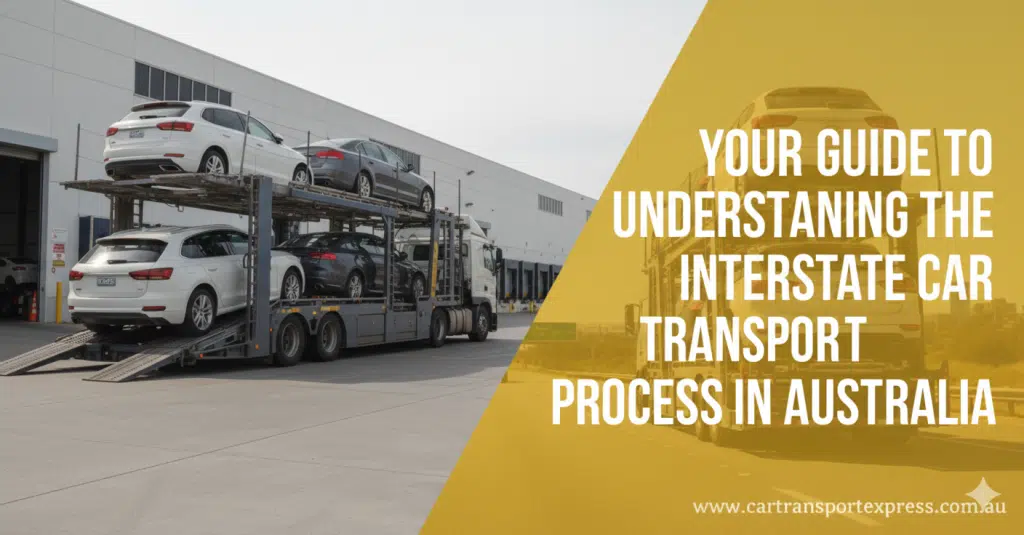
4 min read
What is Interstate Car Transport?
Interstate car transport is the process of moving vehicles from one state or territory to another within Australia. It provides a safe, efficient, and convenient solution for individuals, dealerships, and businesses needing to relocate vehicles across long distances without driving them personally. Instead of putting thousands of kilometres on your car, you can entrust it to professional car transport companies who use purpose-built carriers, coastal shipping services, or a combination of road and rail networks to move vehicles across the country.
Why Choose Interstate Car Transport?
- Convenience and Time Savings: Avoid days of long-distance driving and let professionals handle the logistics while you focus on other priorities.
- Reduced Wear and Tear: Transporting your car prevents unnecessary mileage, tyre wear, and mechanical stress.
- Expertise and Safety: Professional transporters use modern trailers, strapping systems, and safety checks to ensure vehicles are delivered securely.
- Flexible Options: From open multi-car carriers to enclosed prestige transport, you can select a service that suits your budget and protection needs.
How Does Interstate Car Transport Work in Australia?
- Booking & Quoting: Provide details such as pick-up and delivery locations, vehicle type, and timeframe. The company will quote based on distance, route, and carrier type.
- Vehicle Inspection: Condition reports (with photos) are usually completed at collection to record existing marks or damage.
- Preparation: Remove personal belongings, ensure the car is in working order, and keep fuel at around one-quarter of a tank, unless you have selected a “Goods in Car” option, in which case carriers will allow limited personal items in the vehicle (subject to restrictions).
- Pick-Up & Loading: The carrier collects the vehicle, loads it securely, and begins transit via road, rail, or a combination.
- Transit & Tracking: Many providers offer online tracking or status updates so you can monitor progress.
- Delivery & Handover: On arrival, the vehicle is unloaded, inspected, and signed off by you or a nominated representative.
Paperwork and Documentation
Car transport in Australia is straightforward, with only minimal paperwork required:
- Registration Not Required: Your vehicle does not need to be currently registered to be transported interstate. However, it must be safe to load and able to roll, steer, and brake unless you arrange specialised non-runner services.
- Proof of Identity: At delivery, you (or the person collecting the car on your behalf) must provide a valid photo ID. This helps prevent unauthorised release of vehicles.
- Nominated Collection: If you cannot be present, you may nominate a trusted representative to collect your vehicle. Ensure their details are provided in advance to the transport company and that they carry ID matching the booking details.
- Condition Report: Both at pick-up and delivery, a vehicle condition report is completed and signed by both parties. This protects you in the unlikely event of damage claims.
The “Goods in Car” Option
Some car transport companies in Australia allow you to include a limited amount of personal belongings inside your vehicle during transit. This service is commonly referred to as the “Goods in Car” option.
Key Points to Know:
- Weight Limits: Most carriers restrict this to 60–100 kg of personal items, usually confined to the boot and/or back seat.
- Liability: Carriers typically provide no liability cover for personal goods. Their liability applies to the vehicle itself, not its contents. Any loss or damage to items packed inside is at the owner’s risk.
- Security: Items must be securely packed, not obstruct driver visibility, and not include hazardous materials (such as fuel cans, gas bottles, or chemicals).
- No Valuables: Do not pack valuables such as electronics, jewellery, cash, or important documents. These are not protected and should never be transported inside the vehicle.
- Compliance: Overloaded or unsecured vehicles may be refused at collection if they do not meet carrier safety standards.
The Goods in Car option can be a convenient way to move non-essential items, but it should be seen as a low-cost add-on for incidental belongings only, not a replacement for professional removals services.
What to Consider When Choosing a Car Transport Company
- Reputation: Check independent reviews, testimonials, and word-of-mouth.
- Business Legitimacy: Verify the company’s ABN through the Australian Business Register (https://abr.business.gov.au/).
- Carrier’s Liability Cover: Confirm the company provides liability protection for vehicles in transit. This ensures you are covered if your car is damaged while in their care. Request written proof and understand the coverage limits.
- Services Offered: Compare options like depot-to-depot, door-to-door, open vs enclosed carriers, and coastal shipping.
- Pricing: Obtain multiple quotes. Beware of unusually low prices, which can signal corner-cutting.
- Communication: A reliable provider offers clear scheduling, regular updates, and responsive customer support.
Tips to Prepare Your Car for Transport
- Clean Inside and Out: Makes pre-transport inspections more accurate.
- Remove Personal Items (unless using Goods in Car): Most companies will not accept liability for goods left inside the car unless you’ve chosen the option, and even then, valuables should never be included.
- Check Fluids and Battery: Ensure everything is topped up and the vehicle is operational.
- Secure Loose Parts: Remove or tighten accessories like roof racks, antennas, or spoilers.
- Photograph Your Vehicle: Keep a dated record of its condition before transport.
- Fuel Level: Around 25% is sufficient.
Common Myths About Car Transport
- “It will add mileage.” False – vehicles are transported, not driven.
- “It’s unsafe.” Reputable carriers use modern trailers, strapping systems, and liability cover for protection.
- “It’s too expensive.” When factoring in fuel, accommodation, meals, and time off work, transport often works out cheaper than driving yourself.
- “It’s only for cars.” Transport companies also handle 4WDs, SUVs, motorcycles, vans, light trucks, and even boats.
Why Damage Can Occur (and How to Minimise Risk)
- Exposure on Open Carriers: Road debris or severe weather can occasionally cause damage.
- Loose Parts: Poorly secured accessories may detach during transit.
- How to Protect Yourself: Prepare your vehicle properly, choose a reputable company with proper liability cover, and always complete inspections at pick-up and delivery.
Key Takeaways
- Plan ahead – book early, especially around holidays.
- Do your research – choose licensed companies with liability protection.
- Understand timeframes – allow for business days and possible delays.
- Prepare your vehicle – remove personal items (or pack carefully if using Goods in Car), photograph condition, and check basics.
Interstate car transport in Australia offers a safe, efficient, and cost-effective way to move vehicles across long distances. By understanding the process, paperwork, and responsibilities, you can ensure your car arrives securely and on schedule.
Why Fuel Prices Impact Car Transport Costs in Australia
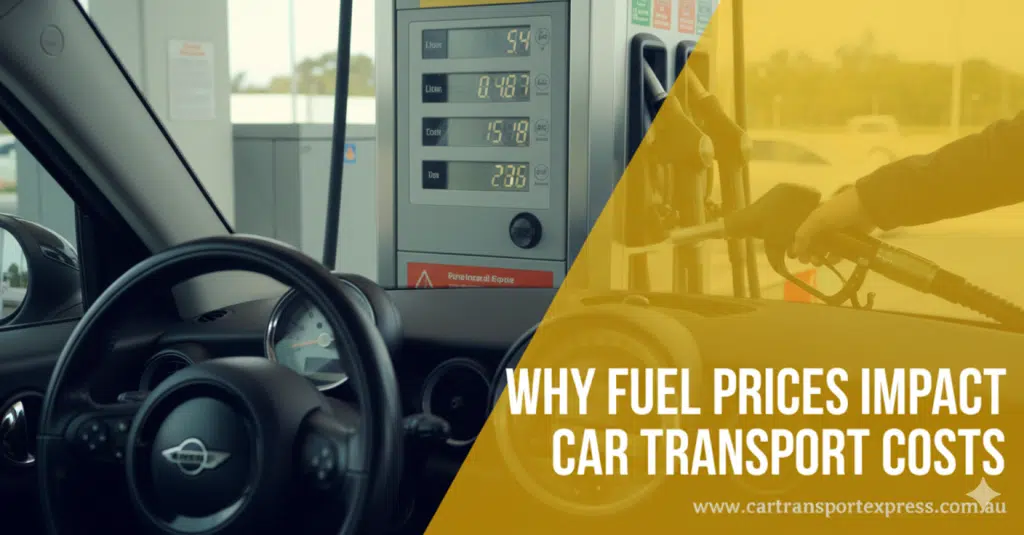
3 min read
Key Takeaways
- Fuel is a core operating expense, Diesel makes up one of the biggest costs for car transporters, and even small price increases per litre significantly raise overall transport costs.
- Global and local factors drive fuel prices, Oil markets, exchange rates, taxes, and regional supply issues all contribute to fuel price volatility in Australia.
- Long distances amplify costs, Remote and interstate routes consume more fuel, making long-haul car transport more sensitive to fuel price changes.
- Fuel surcharges are common, Many carriers include surcharges or flexible pricing mechanisms to account for fluctuating diesel prices.
- Operators use strategies to cut fuel risk, From efficient route planning to backloading trips, transport companies aim to reduce fuel expenses where possible.
- Customers should compare quotes carefully, Always ask whether fuel is included, check for surcharge clauses, and be cautious of quotes that seem unusually low.
When you request an interstate car transport service, one of the biggest cost drivers is fuel. Understanding exactly why fluctuations in fuel prices affect vehicle shipping costs can help you anticipate quote changes and choose a transport provider wisely.
Below is a breakdown of how fuel affects the bottom line in car transport across Australia.
1. Fuel Is a Core Operating Expense for Transporters
Fuel isn’t a marginal cost for car carriers, it’s one of the largest ongoing expenses.
- Every kilometre the trailer travels consumes diesel (or fuel) and as prices rise, the cost per km increases.
- For long interstate hauls, small increases per litre snowball into significant additional costs.
- Transport companies often build fuel costs into their basic pricing models and adjust them as fuel prices change.
- Many providers add a fuel surcharge to their base cost to manage volatility, this surcharge may vary depending on current diesel prices.
- Because of this, when petrol or diesel prices jump, the transport operator’s margin is squeezed unless they pass some or all of that increase to the customer.
2. Diesel Prices in Australia Are Affected by Global and Domestic Factors
Understanding why fuel costs fluctuate helps explain why transport quotes aren’t static.
- Australia imports a portion of its refined fuel, so international crude oil prices and supply disruptions have a direct impact.
- Exchange rates matter: when the Australian dollar weakens versus major currencies like the US dollar, imported fuel becomes more expensive.
- Government levies fuel excise and GST are built into fuel prices.
- Local distribution, transport of fuel itself, and regional variances (e.g., remote areas) also influence pump prices.
Because of these interconnected factors, fuel prices in Australia can shift within weeks or even days, and carriers must respond.
3. Long Distance Hauls Amplify Fuel Cost Impacts
Transporting cars across states often means long stretches between major hubs, sometimes through sparsely populated regions. That amplifies fuel cost sensitivity:
- Every extra litre used on remote stretches is more expensive in absolute terms than in dense areas.
- The farther a route, the greater the proportion of fuel cost relative to fixed costs (driver wages, maintenance, overhead).
- Carriers may need to detour or take less efficient routes, often due to roadworks or restricted access, increasing fuel consumption.
Thus, routes with greater distance or low frequency demand will tend to carry higher margins or surcharges.
4. Fuel Surcharges and Pricing Mechanisms
Because of volatility, many car transport providers use fuel surcharges or escalation clauses to manage risk:
- Instead of quoting a single fixed price, the base rate might exclude fuel fluctuations, with surcharges added based on recent diesel price indexes.
- Some quotes offer “locked-in” fuel pricing for a period; others adjust dynamically.
- It’s common that the surcharge isn’t highlighted clearly in the initial quote, so clients should ask specifically whether fuel is included or if a surcharge may be added later.
Understanding how a carrier handles fuel will help you compare true apples-to-apples costs.
5. Strategies Transporters Use to Mitigate Fuel Risks
To manage rising or volatile fuel costs, transport companies often adopt strategies to reduce
Sensitivities:
- Route optimisation software to shorten distance or avoid traffic delays.
- Fuel-efficient vehicles and trailer designs (improved aerodynamics, lighter materials).
- Bulk fuel purchasing contracts or hedging to lock in lower fuel prices.
- Preventative maintenance and driver training to reduce fuel wastage (e.g. smoother
- acceleration, fewer idle times).
- Backloading or return trips, combining trips so carriers don’t travel empty.
As a client, you may not see all these behind the scenes, but more efficient operators are better positioned to manage fuel-driven cost pressure.
6. What It Means for You as a Customer
Knowing how fuel prices drive costs in the background helps you make smarter decisions:
- When receiving quotes, ask whether fuel is included or whether there is a fuel surcharge clause.
- For longer or remote routes, expect higher sensitivity to fuel changes, so get timeframe flexibility where possible.
- Look for carriers who transparently disclose their pricing models (base cost + surcharges) so you understand what can change.
- Because fuel is unpredictable, booking earlier may lock in better rates.
- Be wary of unusually low quotes, they may assume fuel stays low and may add hidden surcharges later.
Conclusion
Fuel costs are one of the most important factors influencing the price of car transport in Australia. Global oil markets, exchange rates, taxes, and domestic distribution all impact diesel prices and these changes flow directly into the cost of moving vehicles. By understanding these dynamics, customers can better plan, compare quotes effectively, and avoid unexpected surprises in their transport costs.


